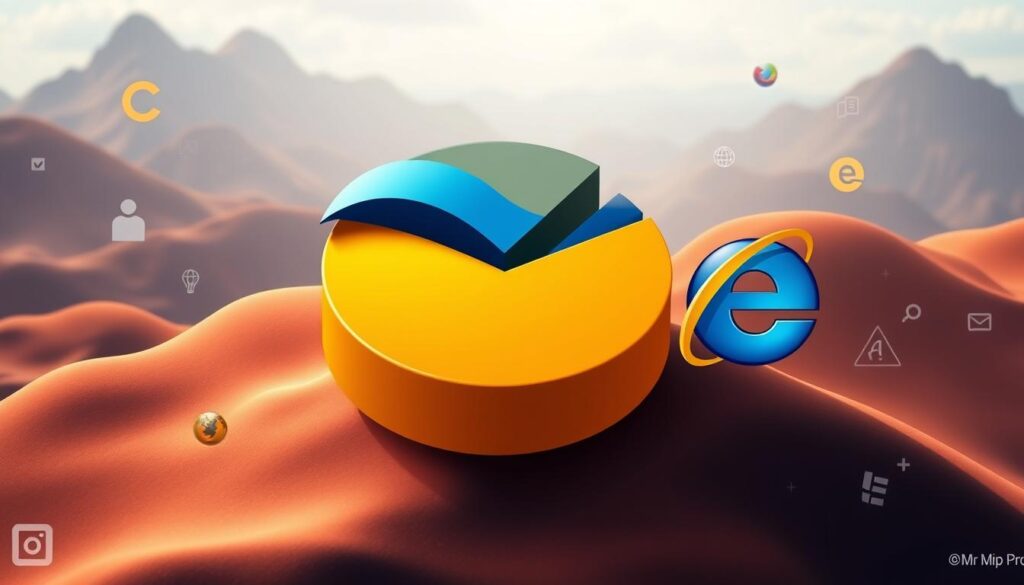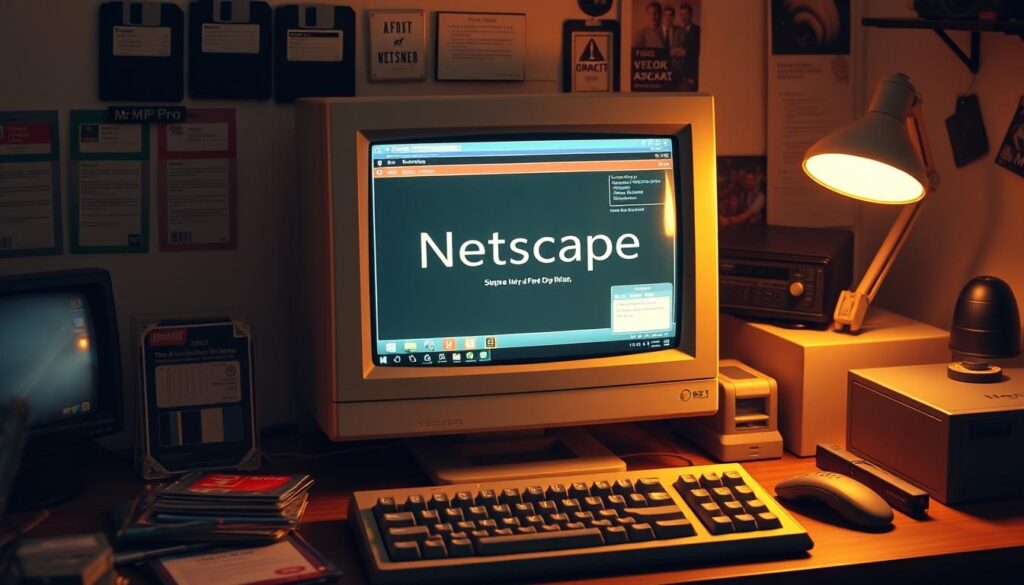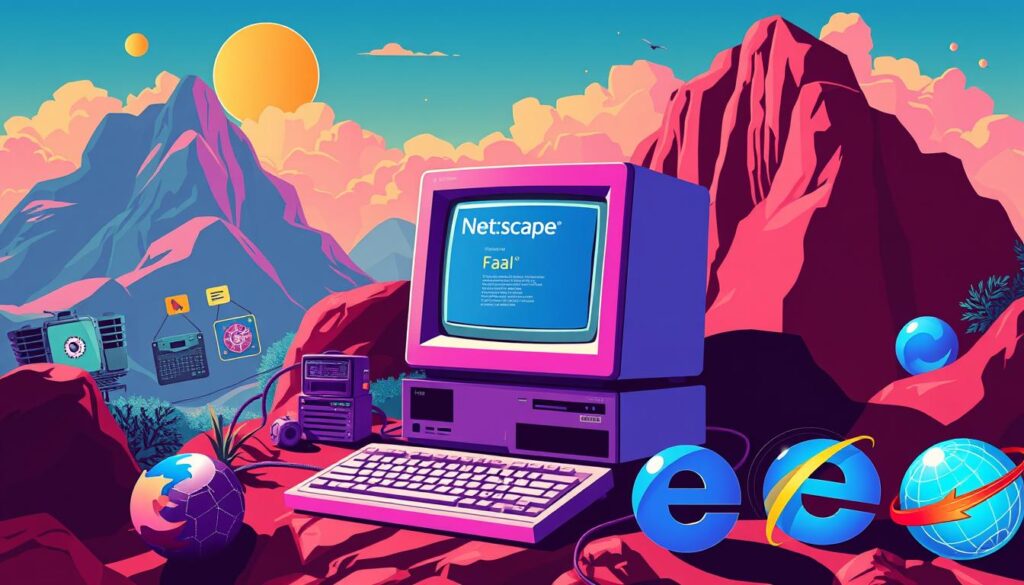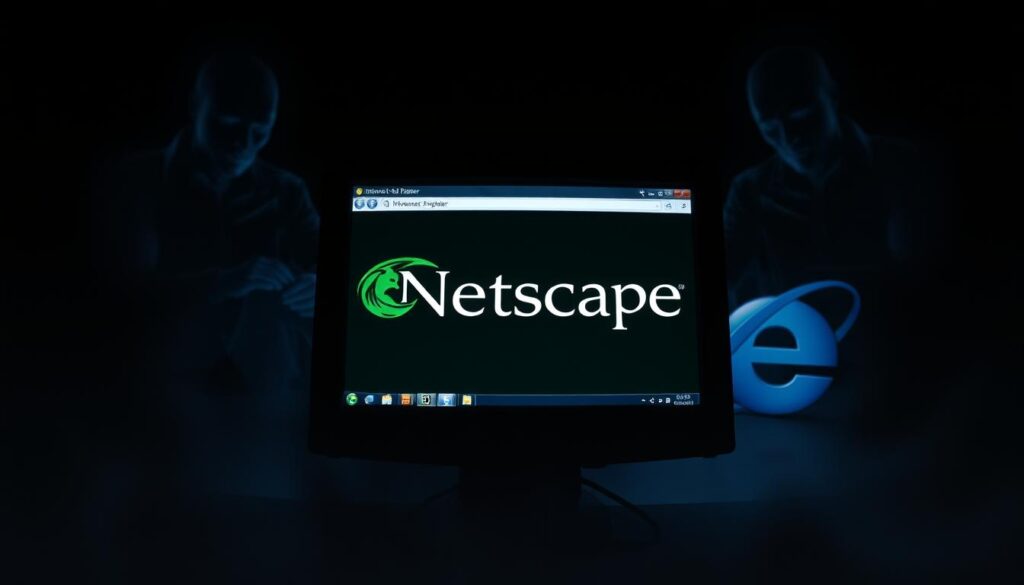
By 2000, Internet Explorer had a 95% market share. This was a huge number that started Netscape’s decline. Netscape was once a leader, holding 90% of the market in 1995. You can find more about how market share affects businesses at e-commerce seo strategies. The story of Netscape’s fall is key to understanding the browser wars.
The downfall of Netscape came from several reasons. One big factor was Internet Explorer becoming the default browser on Windows PCs. This made Internet Explorer the go-to choice for many users. As you learn more about Netscape, you’ll see how its success was brief. Internet Explorer’s rise led to Netscape’s decline, changing the browser market forever.
The Birth of the Modern Web Browser
The netscape web browser’s rise was a big deal for the internet. Marc Andreessen and Jim Clark founded it. Netscape Navigator became popular fast because it was easy to use and had cool features. It was the first commercial web browser, leading to today’s modern browsers.
In the early days, Netscape Navigator was everyone’s favorite browser. It had a huge impact on the internet. Its success came from being easy to use and supporting web standards.
- Support for HTML 3 features
- Inline display of images
- Easy-to-use interface
The netscape web browser changed the internet a lot. Its legacy is seen today. The story of Netscape reminds us of the value of innovation and competition in tech.
| Browser | Release Year | Market Share |
|---|---|---|
| Netscape Navigator | 1994 | 80% |
| Internet Explorer | 1995 | 20% |
Netscape’s Revolutionary Features in Early Versions
Netscape Communications Corporation introduced many groundbreaking features in its early versions. These features helped Netscape become a huge success and gain a big share of the browser market. One key feature was JavaScript, which made web pages more interactive and fun to use.
Another important feature was SSL encryption. It ensured that online transactions were safe and user data was protected. These features made Netscape a favorite among internet users. They helped Netscape lead the browser market in the mid-1990s.
Some of the notable features of Netscape’s early versions include:
- JavaScript for dynamic web pages
- SSL encryption for secure transactions
- Support for multiple platforms, including Unix, Mac, and Windows
These features, along with Netscape’s easy-to-use interface and fast speed, helped it gain a big share of the browser market. Netscape became a top player in the browser world.

Overall, Netscape’s early versions were key in shaping the web browser market. They set the stage for future innovations.
| Feature | Description |
|---|---|
| JavaScript | Allowed for dynamic web pages and enhanced user experience |
| SSL encryption | Provided secure transactions and protected user data |
| Multi-platform support | Supported Unix, Mac, and Windows platforms |
The IPO That Changed Silicon Valley
Netscape’s initial public offer on August 9, 1995, was a big deal for Silicon Valley. The IPO was a huge success, with shares jumping from $28 to $75 that day. This jump was a 178.57% increase, starting the dot-com boom.
The success of Netscape’s IPO opened the door for other tech companies to go public. This led to Netscape facing tough competition. The netscape browser discontinuation happened because Microsoft’s Internet Explorer was winning, being bundled with Windows.

Record-Breaking First Day Trading
Netscape’s IPO set a new record for first-day trading. The stock price went up to $75 before closing at $58.25. This made Netscape worth $2.9 billion, a huge success.
The Dawn of the Dot-com Era
The success of Netscape’s IPO started the dot-com era. This era saw companies like Google, eBay, and Amazon emerge. The rush of the dot-com bubble led to many companies with weird business models trying to get investors.
When the dot-com bubble burst in 2000, the industry fell hard. But Netscape’s IPO’s impact on Silicon Valley and tech was huge and lasting.
Microsoft Enters the Browser Market
Microsoft’s entry into the browser market was a big deal. They launched Internet Explorer to compete with Netscape, which had an 80% market share by mid-1995. Microsoft wanted to make Internet Explorer the default browser in Windows 95.
Microsoft’s actions had a big impact on Netscape. By making Internet Explorer the default browser in Windows 95, it was hard for Netscape to grow. Microsoft’s big resources and marketing helped Internet Explorer become more popular.
Internet Explorer’s Strategic Launch
Internet Explorer came out just 15 days after Netscape’s IPO in 1995. At first, it didn’t hurt Netscape’s share. But Microsoft kept working and planning. They made Internet Explorer a part of Windows, which was used by over 90% of people.
The Windows 95 Integration Strategy
Putting Internet Explorer in Windows 95 was a smart move for Microsoft. It made Internet Explorer the default browser. This meant more people used it, helping Microsoft grow.

- Netscape Navigator released in December 1994
- Internet Explorer version 1 released in 1995
- Microsoft integrates Internet Explorer into Windows 95
- Netscape’s market share declines as Internet Explorer gains traction
Learning about the netscape browser history and its rise and fall helps us understand the browser wars. It shows how Microsoft’s smart moves changed the market.
The Fall of Netscape: A Market Share Analysis
The fall of netscape is a tale of decline and lost market share. After Internet Explorer’s launch, Netscape’s share plummeted. By 1997, Internet Explorer had taken the lead. This shift was due to Internet Explorer 4.0’s speed and richer features compared to Netscape Navigator 4.0.
Several events led to Netscape’s downfall:
- Netscape’s 1998 decision to give away its browser for free hurt their revenue and limited new product development.
- Microsoft’s dominance restricted Netscape access during legal battles.
- Microsoft’s move to bundle Internet Explorer with PCs further reduced Netscape’s market share.
By January 1998, Netscape’s share had dropped sharply. Internet Explorer then took the lead. The fall of netscape highlights the need to adapt and invest in new products.

| Year | Netscape Market Share | Internet Explorer Market Share |
|---|---|---|
| 1995 | 80% | 5% |
| 1997 | 40% | 60% |
| 1998 | 20% | 80% |
Technical Innovation vs. Business Strategy
The rise and fall of Netscape shows the company faced big technical and business hurdles. Its web browser, a leader at first, found it hard to beat Microsoft’s Internet Explorer. Microsoft’s big lead in the market, thanks to preloading their browser on PCs, was a big part of this.
Netscape had to keep innovating to meet user needs. But, Microsoft’s strong hold in the operating system market made it tough for Netscape to catch up.
Netscape’s Development Challenges
Some big challenges for Netscape included:
- Keeping the navigator updated to meet user needs
- Competing with Internet Explorer, already on many PCs
- Coming up with new features to stay ahead
Microsoft’s Distribution Advantage
Microsoft’s big lead was a key to their success. By putting Internet Explorer on millions of PCs, they reached many users. This made it hard for Netscape, even with its tech advances.

In the end, the fight between Netscape and Microsoft was about more than tech. It was also about business strategy. Netscape’s innovative browser couldn’t beat Microsoft’s wide reach, leading to its downfall.
| Browser | Market Share (1998) |
|---|---|
| Netscape Navigator | less than 1% |
| Internet Explorer | over 70% |
The Browser Wars Heat Up
The battle between Netscape and Microsoft was fierce. Both fought hard for netscape browser market share. By late 1996, Internet Explorer had over 20% of the market. Netscape Navigator, on the other hand, had more than 80%.
This change was mainly because of Microsoft’s smart move. They launched Internet Explorer and tied it to Windows 95.
As the fight went on, netscape communications corporation found it tough to keep its lead. Netscape’s share started to drop. By the end of 1998, Internet Explorer was at 65%, and Netscape was below 40%.
This was a big moment in the browser wars. It showed a clear shift in power towards Microsoft.
The browser wars changed the internet a lot. They pushed companies to innovate and compete. The story of Netscape’s rise and fall, and Internet Explorer’s dominance, shows how fast the tech world changes.
Understanding the history of the browser wars is key. It helps us see how the internet has evolved.
Microsoft’s Controversial Tactics
Microsoft used several tactics to beat Netscape in the browser wars. The fall of netscape was due to these strategies. They included giving away browsers for free and making them part of the operating system.
By bundling Internet Explorer with Windows, Microsoft made it hard for Netscape to keep up. This move made Internet Explorer more popular than Netscape Navigator, which users had to download.
Key Tactics Used by Microsoft
- Free browser distribution
- Operating system integration
- Exclusive deals with OEMs
These strategies led to Microsoft’s big win in the browser market. By 2002, Internet Explorer had about 95% of the market. The fall of netscape and the netscape downfall show how important fair play and innovation are in tech.

| Year | Internet Explorer Market Share | Netscape Navigator Market Share |
|---|---|---|
| 1995 | 0% | 90% |
| 2002 | 95% | 5% |
The Antitrust Case Against Microsoft
The antitrust case against Microsoft was a big deal in the browser wars. It was a key moment in the rise and fall of netscape. The US government said Microsoft used unfair practices to beat the netscape web browser.
Some important facts about the case are:
- Microsoft was accused of creating a monopoly that led to the collapse of rival Netscape.
- The company was alleged to have given its browser software away for free, undermining Netscape’s business model.
- The Sherman Antitrust Act, established in 1890, was cited as the basis for the case against Microsoft.
The case ended with a settlement. Microsoft agreed to share computing interfaces with other companies. This avoided the need to split into two separate entities. The rise and fall of netscape shows how vital fair competition is in tech. It also highlights the need for companies like Microsoft to follow antitrust laws when promoting their products, like the netscape web browser.

| Company | Product | Year |
|---|---|---|
| Microsoft | Internet Explorer | 1995 |
| Netscape | Netscape Navigator | 1994 |
Netscape’s Response to Market Pressure
In the late 1990s, netscape faced a lot of market pressure. The company made some big changes and mistakes. One major move was the AOL acquisition, which changed netscape’s path.
The AOL deal made netscape focus more on groupware software. But, this change didn’t stop netscape’s market share from falling. Netscape’s share went from 90% in 1995 to 40% in 1999, as Internet Explorer grew.
Some key moments in netscape’s fight against market pressure include:
- The launch of Internet Explorer 4.0 in late 1997, which sharply reduced netscape’s users.
- Microsoft introduced Internet Explorer version 3.0 in August 1996, becoming a strong competitor to Navigator.
- Netscape decided to market its product more aggressively to try and keep its share.

In the end, netscape’s efforts to fight market pressure didn’t work. The company’s changes, including the AOL deal, couldn’t stop Internet Explorer’s rise.
| Year | Netscape Market Share | Internet Explorer Market Share |
|---|---|---|
| 1995 | 90% | 8% |
| 1997 | 64% | 32% |
| 1999 | 40% | 60% |
The Birth of Mozilla and Firefox
After the rise and fall of netscape, a group of developers started a new browser project. This project would become Firefox. It marked the start of a new chapter in web browsing.
The Mozilla project was launched in 1998. It was created with the Netscape browser suite source code. This allowed for a community-driven approach to browser development.
Firefox was first released in 2004. It quickly became popular, with over 100 million downloads in less than a year. Its speed, security, and customizability made it a favorite among users.
To learn more about Firefox’s history and development, visit the Mozilla website.
Some key milestones in Firefox’s development include:
- 2002: Mozilla 1.0 was released, marking a significant milestone in the project’s history.
- 2004: Firefox 1.0 was released, which was downloaded over 100 million times within less than a year.
- 2013: Firefox OS was launched to target the smartphone market and provide additional browsing choices for users.
The story of Mozilla and Firefox shows the power of community-driven development. It highlights the impact on the rise and fall of netscape and the web browser market. When choosing a netscape web browser, remember to look for speed, security, and customizability.
| Year | Event |
|---|---|
| 1998 | Mozilla project was created |
| 2002 | Mozilla 1.0 was released |
| 2004 | Firefox 1.0 was released |
Open Source Legacy
Netscape’s choice to open-source its browser code changed web development forever. This move encouraged other open-source projects. It also let developers help grow the internet. The fall of Netscape marked a big change in the web’s history, leading to new browsers and tech.
The downfall of Netscape was due to Internet Explorer’s rise and the company’s struggle to keep up. Yet, Netscape’s legacy lives on. It’s seen in open-source projects and its lasting impact on the web.
Impact on Modern Web Development
Netscape’s open-source legacy inspired many developers. Today, using open-source code is common in web development. It has led to the making of new browsers and technologies.
Contemporary Browser Market
Now, browsers like Google Chrome, Mozilla Firefox, and Microsoft Edge rule the market. Netscape’s fall helped these browsers grow. It opened the door for new web development innovations.
| Year | Netscape Navigator | Internet Explorer | Google Chrome | Mozilla Firefox |
|---|---|---|---|---|
| 1995 | 90% | 0% | 0% | 0% |
| 2000 | 20% | 80% | 0% | 0% |
| 2010 | 1% | 60% | 20% | 20% |
Lessons from Netscape’s Downfall
Looking back at Netscape, we see it couldn’t keep up with market changes. It also couldn’t beat Microsoft’s reach. Netscape’s browser once led the web, but Internet Explorer took over. The company, once a leader, found it hard to meet user needs.
Netscape’s story warns us about the need for innovation and quick changes. Key lessons include:
- Keep innovating and improving to stay ahead.
- Adjust to new market trends and user wants.
- Have a strong business plan, knowing who you’re up against.
By studying Netscape’s fall, we learn the value of being quick and flexible. Netscape’s market share may have dropped, but its lessons help today’s tech companies.
Remembering Netscape’s impact on the internet and tech is important. Even though it’s not as big, its legacy lives on. Learning from its wins and losses helps us understand the tech world better.
Modern Browser Market Dynamics
The rise and fall of Netscape has changed the browser market a lot. Now, Chrome leads the way, with users focusing on privacy and security. You can find out more about the browser wars and their impact on the industry.
Chrome’s Dominance
Chrome is popular because it’s fast, secure, and easy to use. It’s the top choice for many, and its popularity keeps growing. Some of Chrome’s key features include:
- Fast page loading
- Robust security features
- Extensive library of extensions
Browser Privacy and Security Today
Today, users worry a lot about privacy and security online. With more threats and data breaches, they seek browsers that offer safety and privacy. Netscape was early in adding security features, and its influence is seen in today’s browsers. Here’s a comparison of different browsers’ security features:
| Browser | Security Features |
|---|---|
| Chrome | Incognito mode, password manager, phishing protection |
| Firefox | Private browsing mode, password manager, tracking protection |
| Edge | InPrivate browsing mode, password manager, phishing protection |
In summary, the browser market today is complex and ever-changing. Chrome’s lead and the focus on privacy and security are key. Netscape’s impact is clear in today’s browsers.
Conclusion: The Legacy of the Browser Wars
The browser wars between Netscape and Microsoft have changed the internet and tech world. This fierce competition pushed innovation and shaped today’s browser market. It also showed how important business strategy is online.
Netscape’s Navigator opened the web to many users. Microsoft’s Internet Explorer became a big player by being bundled with Windows. This battle showed the struggle to keep up with big distribution power.
The browser wars’ impact is seen in open-source browsers like Mozilla Firefox. They’ve also made browsers focus more on security and speed. Today, Google Chrome leads, Microsoft Edge is back, and niche browsers meet specific needs.
The browser wars teach us a lesson. Even the most innovative can fall to smart business moves. As you use the web today, remember the lessons and progress from those early days.

 The Fall of Netscape: How Internet Explorer Crushed an Innovator
The Fall of Netscape: How Internet Explorer Crushed an Innovator
0 Comment